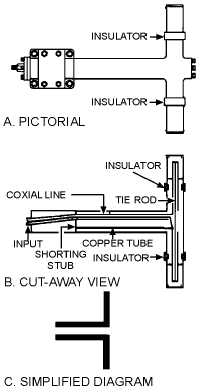1-35
Figure 1-24.—Antenna.
COMPONENTS OF THE ELECTROMAGNETIC WAVE
An electromagnetic wave consists of two primary components—an ELECTRIC FIELD and a
MAGNETIC FIELD. The electric field results from the force of voltage, and the magnetic field results
from the flow of current.
Although electromagnetic fields that are radiated are commonly considered to be waves, under
certain circumstances their behavior makes them appear to have some of the properties of particles. In
general, however, it is easier to picture electromagnetic radiation in space as horizontal and vertical lines
of force oriented at right angles to each other. These lines of force are made up of an electric field (E) and
a magnetic field (H), which together make up the electromagnetic field in space.
The electric and magnetic fields radiated from an antenna form the electromagnetic field. This field
is responsible for the transmission and reception of electromagnetic energy through free space. An
antenna, however, is also part of the electrical circuit of a transmitter or a receiver and is equivalent to a
circuit containing inductance, capacitance, and resistance. Therefore, the antenna can be expected to
display definite voltage and current relationships with respect to a given input. A current through the
antenna produces a magnetic field, and a charge on the antenna produces an electric field. These two
fields combine to form the INDUCTION field. To help you gain a better understanding of antenna theory,
we must review some basic electrical concepts. We will review voltage and its electric field, current and
its magnetic field, and their relationship to propagation of electrical energy.
Q44. What are the two components (fields) that make up the electromagnetic wave?

